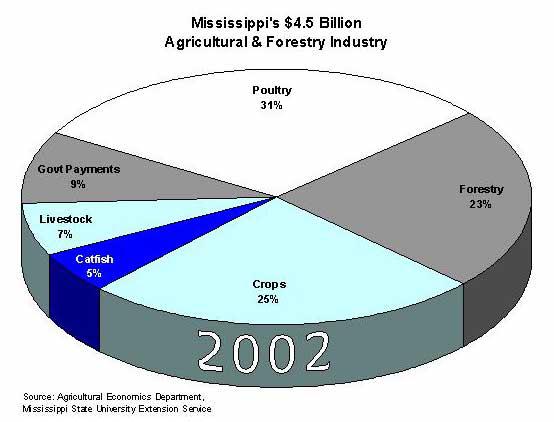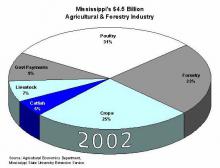Information Possibly Outdated
The information presented on this page was originally released on December 16, 2002. It may not be outdated, but please search our site for more current information. If you plan to quote or reference this information in a publication, please check with the Extension specialist or author before proceeding.
Mississippi's largest crops struggle in 2002
MISSISSIPPI STATE -- A victim of low market prices, a Russian ban and a wet harvest season, Mississippi's 2002 total value of agricultural production is expected to decrease by almost 7 percent from the previous year.
While some commodities posted significant gains over their previous year's total, the state's big three -- poultry, forestry and cotton -- all posted losses. Mississippi State University agricultural economists predict Mississippi's total value of production for 2002 to be $4.5 billion, compared to $4.9 billion in 2001.
John Anderson, agricultural economist with MSU's Extension Service, said poultry will retain its top spot with a value of $1.4 billion, despite its 17 percent decline from 2001 figures.
|
(Estimated in millions) |
|
|
1. Poultry |
1,374 |
|
2. Forestry |
1,065 |
|
3. Cotton* |
432 |
|
4. Soybeans* |
261 |
|
5. Catfish |
241 |
|
6. Cattle/calves |
194 |
|
7. Corn* |
157 |
|
8. Hay* |
77 |
|
9. Horticultural crops* |
80 |
|
10. Milk |
65 |
|
11. Rice* |
62 |
|
12. Hogs |
41 |
|
13. Sweet potatoes* |
38 |
|
14. Wheat* |
27 |
|
15. Grain sorghum* |
12 |
|
*Agronomic crops' total |
1,150 |
"The Russian ban on U.S. poultry only lasted six or seven weeks, but it took much more time to recover. In fact, we may never fully regain the market we lost to Brazil, China and domestic Russian poultry producers," Anderson said. "The ample supply of all meat products hurt livestock and catfish prices as well."
Total value of cattle/calves, milk and hogs is expected to drop 14 percent in 2002 to about $300 million. Cattle/calves are valued at $194 million, down 8 percent, and milk's value is $65 million, down 19 percent. The biggest percentage losses for 2002 will be the 31 percent decline for hogs. Their value is predicted at $44 million.
Terry Hanson, MSU agricultural economist, said demand for catfish could not compensate for the oversupply, which resulted in a 7 percent decrease from 2001's value. Catfish are valued at $241 million for 2002.
"Growers have tried to cut back on feed and grow their fish slower or not stock their ponds as densely," Hanson said. "Stocker and fingerling inventories are going down. There has not been any expansion in the state since 2001. If prices do not improve, some catfish farms may consolidate with others or close altogether."
Anderson said forestry is repeating as the state's second largest single commodity with a predicted value of $1.06 billion, a decline of only 1 percent. The decline was more drastic from 2000 to 2001 when forestry's value decreased 17 percent.
"We certainly hope this small decrease for 2002 represents a leveling off for the timber industry and the sign of better economic conditions in 2003," Anderson said.
All agronomic crops combined to slightly edge forestry with a total value of $1.15 billion. Cotton is still king with a $432 million value despite an almost 2 percent decline from 2001, largely due to late season crop losses. Increased acreage and improved prices helped bolster soybean and corn values by 59 and 57 percent respectively. Soybeans are valued at $261 million, and corn is valued at $157 million.
The largest percentage decline among agronomic crops is predicted for rice, which declined almost 22 percent -- from $80 million to $63 million.
"Cotton was on track for an enormous crop until Tropical Storm Isidore and Hurricane Lili dumped a ton of rain on the state. Growers' cotton lost quality, and they struggled to harvest later maturing fields, especially in the northeastern counties," Anderson said. "When the impact of quality losses is fully realized, the value of the state's 2002 crop could drop even more. An additional factor in cotton's value decline is the decrease in acreage from the unusually high acreage in 2001."
Anderson said corn and soybeans benefitted from the increased acreage as well as improved prices. Corn prices were up 15 to 20 percent to between $2.20 and $2.60 per bushel, and soybeans were up 10 to 20 percent to between $4.95 and $5.85 per bushel.
"Improvements in corn and soybean prices may reduce the amount of government payments nationally. Payments will not likely decline as much here as in other states because of the importance of cotton and rice production in Mississippi," he said. "Projections from USDA are for about a 20 percent decline in payments. Still, the total will be around $415 million."



